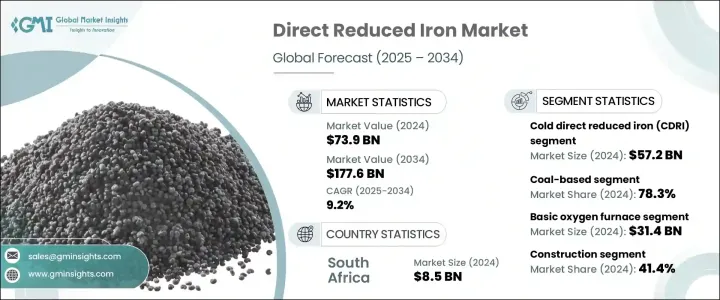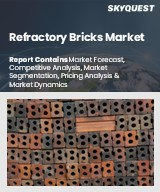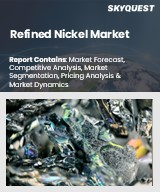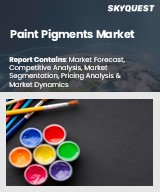
|
시장보고서
상품코드
1716539
직접 환원철 시장 : 기회, 성장 촉진요인, 산업 동향 분석 및 예측(2025-2034년)Direct Reduced Iron Market Opportunity, Growth Drivers, Industry Trend Analysis, and Forecast 2025 - 2034 |
||||||
세계의 직접 환원철(DRI) 시장은 2024년에 739억 달러로 평가되었고, 2025년부터 2034년에 걸쳐 CAGR 9.2%로 견조하게 성장할 것으로 예측됩니다.
건설, 자동차, 제조 등의 산업에서 지속 가능한 생산 방식에 대한 관심이 높아짐에 따라 DRI에 대한 수요는 계속해서 증가하고 있습니다. 철광석에서 추출한 이 고품질 금속 제품은 기존의 철광석 기반 생산 방식에 비해 더 깨끗하고 에너지 효율적인 대안을 제공함으로써 철강 산업에 혁신을 일으키고 있습니다. 환경적으로 책임 있는 제철로 전환하는 추세에 따라 DRI는 탄소 배출을 줄이고 에너지 소비를 최적화하여 기존 제철 공정을 대체하는 핵심 요소로 자리 잡고 있습니다.

DRI 산업은 기술 발전과 지속 가능성에 대한 전 세계적인 강조로 인해 급속한 변화를 겪고 있습니다. 주요 성장 촉매 중 하나는 석탄 기반 방식에 비해 CO2 배출량을 크게 줄이는 수소 기반 및 천연가스 기반 환원 공정의 채택입니다. 철강 제조업체들은 고철 의존도를 낮추고 제품 일관성을 높이기 위해 전기 아크로(EAF)에 DRI를 점점 더 많이 통합하고 있습니다. 또한, 보다 컴팩트하고 운송 친화적인 용선철(HBI)의 도입으로 물류가 간소화되고 시장 범위가 확대되고 있습니다. 세계 규제 프레임워크가 탄소 배출 기준을 강화함에 따라 철강 생산업체들은 더 깨끗한 대안으로 전환을 가속화하고 있으며, DRI는 지속 가능한 철강 제조의 미래에 필수적인 요소로 자리 잡고 있습니다.
| 시장 범위 | |
|---|---|
| 시작 연도 | 2024년 |
| 예측 연도 | 2025-2034년 |
| 시작 금액 | 739억 달러 |
| 예측 금액 | 1,776억 달러 |
| CAGR | 9.2% |
냉간 직접 환원철(CDRI) 시장은 2024년에 572억 달러를 창출했습니다. 따라서 인프라, 중장비, 자동차 용도로 사용되는 고급강의 원료로서 이상적입니다.
2024년 냉간 직접 환원철(CDRI) 시장은 572억 달러 규모를 형성했습니다. CDRI는 고품질 철강 생산, 특히 전기로에서 제강 공정과 원활하게 통합되는 고품질 철강 생산에 선호되는 선택입니다. 순도가 우수하고 불순물이 적어 인프라, 중장비 및 자동차에 사용되는 프리미엄 강종에 이상적인 원료입니다. 엄격한 환경 규제로 인해 산업계가 저공해 솔루션으로 전환함에 따라 CDRI는 기존 제철의 친환경적 대안으로 주목받고 있습니다.
남아프리카의 직접 환원철 시장은 2024년 85억 달러를 창출했습니다. 전 세계 산업계가 탄소 발자국을 줄이기 위한 노력을 강화함에 따라 남아공과 같은 지역에서는 DRI 채택이 급증하고 있습니다. 에너지 효율을 개선하고 탄소 중립을 촉진하기 위한 정부 정책으로 인해 철강 생산업체들은 지속 가능한 기술에 투자하고 있습니다. 친환경 제조에 중점을 두고 있는 이 지역은 친환경 철강 생산으로 전환하는 데 있어 핵심적인 역할을 하고 있습니다.
목차
제1장 조사 방법과 조사 범위
제2장 주요 요약
제3장 업계 인사이트
- 생태계 분석
- 밸류체인에 영향을 주는 요인
- 이익률 분석
- 혁신
- 장래의 전망
- 제조업체
- 유통업체
- 공급자의 상황
- 이익률 분석
- 주요 뉴스
- 규제 상황
- 영향요인
- 성장 촉진요인
- 지속 가능하고 에너지 효율적인 철강 생산 방법의 채택
- DRI 생산 공정의 기술 발전
- 개발 도상국의 철강 수요 증가
- 업계의 잠재적 위험 및 과제
- 철광석 및 천연 가스와 같은 원자재의 변동성 가격
- DRI 생산 시설에 대한 높은 자본 투자
- 성장 촉진요인
- 성장 가능성 분석
- Porter's Five Forces 분석
- PESTEL 분석
제4장 경쟁 구도
- 소개
- 기업 점유율 분석
- 경쟁 포지셔닝 매트릭스
- 전략 전망 매트릭스
제5장 시장 추계 및 예측 : 제품 유형별(2021-2034년)
- 주요 동향
- 열간 연탄 철
- 냉간 직접 환원철(CDRI)
제6장 시장 추계 및 예측 : 기술별(2021-2034년)
- 주요 동향
- 가스 기반
- 석탄 기반
제7장 시장 추계 및 예측 : 용도별(2021-2034년)
- 주요 동향
- 전기 아크로
- 염기성 산소로
- 주조
- 기타
제8장 시장 추계 및 예측 : 최종 용도별(2021-2034년)
- 주요 동향
- 건설
- 자동차
- 항공우주
- 기계 및 설비
- 전기 및 전자
- 재생 에너지
- 기타
제9장 시장 추계 및 예측 : 지역별(2021-2034년)
- 주요 동향
- 북미
- 미국
- 캐나다
- 유럽
- 독일
- 영국
- 프랑스
- 스페인
- 이탈리아
- 네덜란드
- 아시아태평양
- 중국
- 인도
- 일본
- 호주
- 한국
- 라틴아메리카
- 브라질
- 멕시코
- 아르헨티나
- 중동 및 아프리카
- 사우디아라비아
- 남아프리카
- 아랍에미리트(UAE)
제10장 기업 프로파일
- ArcelorMittal
- Essar
- JFE Steel
- JSW Steel
- Kobe Steel
- Metinvest Holding
- MIDREX Technologies
- Mobarakeh steel
- NLMK Group
- NUCOR Corporation
- Qatar Steel Company
- Sinosteel Corporation
- Tata Steel
- Tenova
- Ternium
The Global Direct Reduced Iron Market was valued at USD 73.9 billion in 2024 and is projected to expand at a robust CAGR of 9.2% from 2025 to 2034. As industries such as construction, automotive, and manufacturing intensify their focus on sustainable production methods, the demand for DRI continues to gain momentum. This high-quality metallic product, derived from iron ore, is revolutionizing the iron and steel industry by offering a cleaner, more energy-efficient alternative to traditional iron ore-based production. With a growing shift toward environmentally responsible steelmaking, DRI is becoming a key substitute for conventional ironmaking processes, reducing carbon emissions and optimizing energy consumption.

The DRI industry is undergoing rapid transformation, driven by technological advancements and increasing global emphasis on sustainability. One of the primary growth catalysts is the adoption of hydrogen-based and natural gas-based reduction processes, which significantly cut down CO2 emissions compared to coal-based methods. Steel manufacturers are increasingly integrating DRI into electric arc furnaces (EAFs) to reduce reliance on scrap steel and enhance product consistency. Furthermore, the adoption of hot briquetted iron (HBI), a more compact and transport-friendly version of DRI, is streamlining logistics and expanding market reach. As global regulatory frameworks tighten carbon emission norms, steel producers are accelerating their transition toward cleaner alternatives, positioning DRI as a vital component in the future of sustainable steel manufacturing.
| Market Scope | |
|---|---|
| Start Year | 2024 |
| Forecast Year | 2025-2034 |
| Start Value | $73.9 Billion |
| Forecast Value | $177.6 Billion |
| CAGR | 9.2% |
The cold direct reduced iron (CDRI) market generated USD 57.2 billion in 2024. CDRI is a preferred choice for high-quality steel production, particularly in electric arc furnaces, where it seamlessly integrates with steelmaking processes. Its superior purity and reduced impurities make it an ideal raw material for premium steel grades used in infrastructure, heavy machinery, and automotive applications. With stringent environmental regulations pushing industries toward lower-emission solutions, CDRI continues to gain traction as an eco-friendly alternative to traditional ironmaking.
In terms of production technology, the coal-based segment accounted for a dominant 78.3% share in 2024. Despite the growing emphasis on cleaner alternatives, coal-based DRI production remains the most cost-efficient and widely adopted technique, especially in regions abundant in coal resources. The process enables large-scale production at relatively low operational costs, making it an attractive option in rapidly industrializing economies. Steel manufacturers continue to rely on this method to meet increasing demand while balancing economic feasibility, ensuring the segment's continued market dominance.
The South Africa direct reduced iron market generated USD 8.5 billion in 2024. As global industries intensify their commitment to reducing carbon footprints, regions such as South Africa are witnessing a surge in DRI adoption. Government policies aimed at improving energy efficiency and promoting carbon neutrality are driving steel producers to invest in sustainable technologies. With a strong focus on green manufacturing, the region is positioning itself as a key player in the transition toward eco-friendly steel production.
Table of Contents
Chapter 1 Methodology & Scope
- 1.1 Market scope & definition
- 1.2 Base estimates & calculations
- 1.3 Forecast calculation
- 1.4 Data sources
- 1.4.1 Primary
- 1.4.2 Secondary
- 1.4.2.1 Paid sources
- 1.4.2.2 Public sources
Chapter 2 Executive Summary
- 2.1 Industry synopsis, 2021-2034
Chapter 3 Industry Insights
- 3.1 Industry ecosystem analysis
- 3.1.1 Factor affecting the value chain
- 3.1.2 Profit margin analysis
- 3.1.3 Disruptions
- 3.1.4 Future outlook
- 3.1.5 Manufacturers
- 3.1.6 Distributors
- 3.2 Supplier landscape
- 3.3 Profit margin analysis
- 3.4 Key news & initiatives
- 3.5 Regulatory landscape
- 3.6 Impact forces
- 3.6.1 Growth drivers
- 3.6.1.1 Adoption of sustainable and energy-efficient steel production methods
- 3.6.1.2 Technological advancements in DRI production processes
- 3.6.1.3 Rising steel demand in developing economies
- 3.6.2 Industry pitfalls & challenges
- 3.6.2.1 Volatile prices of raw materials like iron ore and natural gas
- 3.6.2.2 High capital investment for DRI production facilities
- 3.6.1 Growth drivers
- 3.7 Growth potential analysis
- 3.8 Porter's analysis
- 3.9 PESTEL analysis
Chapter 4 Competitive Landscape, 2024
- 4.1 Introduction
- 4.2 Company market share analysis
- 4.3 Competitive positioning matrix
- 4.4 Strategic outlook matrix
Chapter 5 Market Estimates and Forecast, By Product Type, 2021 – 2034 (USD Billion) (Kilo Tons)
- 5.1 Key trends
- 5.2 Hot briquetted iron
- 5.3 Cold direct reduced iron
Chapter 6 Market Estimates and Forecast, By Technology, 2021 – 2034 (USD Billion) (Kilo Tons)
- 6.1 Key trends
- 6.2 Gas-based
- 6.3 Coal-based
Chapter 7 Market Estimates and Forecast, By Application, 2021 – 2034 (USD Billion) (Kilo Tons)
- 7.1 Key trends
- 7.2 Electric arc furnace
- 7.3 Basic oxygen furnace
- 7.4 Foundries
- 7.5 Others
Chapter 8 Market Estimates and Forecast, By End Use, 2021 – 2034 (USD Billion) (Kilo Tons)
- 8.1 Key trends
- 8.2 Construction
- 8.3 Automotive
- 8.4 Aerospace
- 8.5 Machinery & equipment
- 8.6 Electrical & electronic
- 8.7 Renewable energy
- 8.8 Others
Chapter 9 Market Estimates and Forecast, By Region, 2021 – 2034 (USD Billion) (Kilo Tons)
- 9.1 Key trends
- 9.2 North America
- 9.2.1 U.S.
- 9.2.2 Canada
- 9.3 Europe
- 9.3.1 Germany
- 9.3.2 UK
- 9.3.3 France
- 9.3.4 Spain
- 9.3.5 Italy
- 9.3.6 Netherlands
- 9.4 Asia Pacific
- 9.4.1 China
- 9.4.2 India
- 9.4.3 Japan
- 9.4.4 Australia
- 9.4.5 South Korea
- 9.5 Latin America
- 9.5.1 Brazil
- 9.5.2 Mexico
- 9.5.3 Argentina
- 9.6 Middle East and Africa
- 9.6.1 Saudi Arabia
- 9.6.2 South Africa
- 9.6.3 UAE
Chapter 10 Company Profiles
- 10.1 ArcelorMittal
- 10.2 Essar
- 10.3 JFE Steel
- 10.4 JSW Steel
- 10.5 Kobe Steel
- 10.6 Metinvest Holding
- 10.7 MIDREX Technologies
- 10.8 Mobarakeh steel
- 10.9 NLMK Group
- 10.10 NUCOR Corporation
- 10.11 Qatar Steel Company
- 10.12 Sinosteel Corporation
- 10.13 Tata Steel
- 10.14 Tenova
- 10.15 Ternium



















